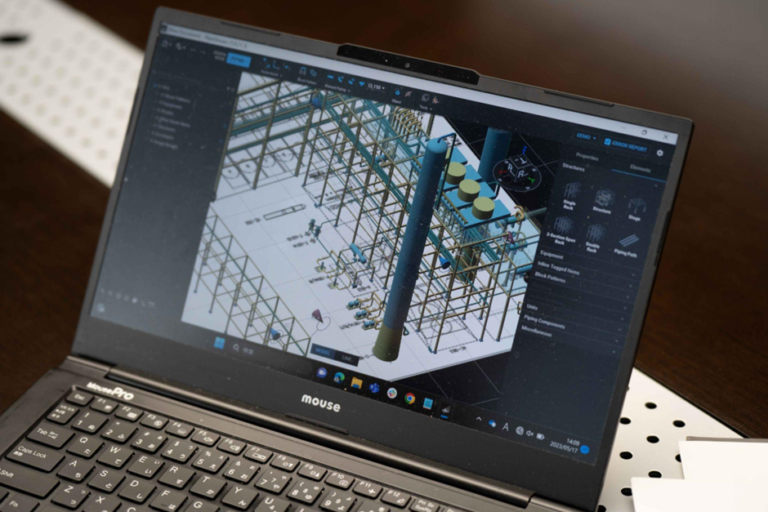Kawasaki Heavy Industries Ltd. is one of Japan’s three major heavy industry manufacturers. With roots in shipbuilding, the company’s history dates back to 1896. Today, its operations span five main categories: Aerospace Systems, Vehicle Business, Motorcycle & Engine Business, Precision Machinery & Robotics, and Energy Solutions & Marine Business, with a significant global presence in each domain.
We had the pleasure of speaking with Kazuhito Tago, Section Manager of the Piping Engineering Department at Kawasaki Heavy Industries’ Energy Solutions & Marine Engineering Company Project Headquarters, and Yuta Tsukamoto, Assistant Manager of the Piping Engineering Department, Section 2. Both have worked on nation-scale projects, such as designing the world’s largest GTG (Gas to Gasoline) plant in Turkmenistan, and developing a liquid hydrogen production plant using Japan’s first domestically designed and produced liquid hydrogen production machine, created by Kawasaki Heavy Industries.
Tago and Tsukamoto saw potential in the next-generation 3D CAD software PlantStream to streamline design and estimation tasks during the FS/FEED stages of plant construction. We delved into their journey of officially adopting PlantStream, the unique advantages they’ve discovered through using it, and their future expectations from the software.
Interview on the application of PlantStream in the Piping Engineering Department of a Comprehensive Heavy Industrial Manufacturer

Tsukamoto: I believe the trigger was an article in either the Nikkei* newspaper or an industry publication. It reported that a new company called PlantStream, funded by long-standing player in the plant industry, Chiyoda Corporation, had released an advanced 3D CAD software called PlantStream that could be used at the FS/FEED stage. Engineers like us were genuinely excited by the news, recognizing that this software was exactly what we had been eagerly anticipating. (*Japan Economic Times )
I began my journey at Kawasaki Heavy Industries in 2009 as a fresh graduate. Even at that time, there were discussions about the eventual automation of plant piping design. However, over a decade into my career, automation still hadn’t made significant strides within the industry. Then, a game-changing product called “PlantStream” was launched in 2020. Intrigued, several colleagues at our company expressed interest in the software, prompting me to reach out to PlantStream.

(Yuta Tsukamoto, Assistant Manager, Piping Engineering Department, Section 2, Project Engineering Division, Energy Solution & Marine Engineering Company, Kawasaki Heavy Industries, Ltd.)

Tago: In our Kobe factory’s Energy Solutions & Marine Engineering Company, we oversee the comprehensive spectrum of activities encompassing planning, design, construction, manufacturing, and, in certain instances, sales and post-sales service provision for industrial facilities. These range from chemical and non-ferrous metal plants, environmental preservation structures such as municipal waste incineration plants, and ultra-low temperature storage tanks catering to LNG and LPG. Additionally, Kawasaki Heavy Industries has actively driven endeavors centered on hydrogen, aligning with decarbonization efforts from an early stage.
In the Piping Engineering Department where I serve as a manager, we mainly focus on chemical and energy plants and, more recently, plants aimed at Carbon Neutral (CN) resources including liquid hydrogen. In contrast, Tsukamoto’s section mainly deals with environmental preservation solutions, including waste treatment plants. In both departments, during the FS/FEED phase, most projects predominantly involve manual and human-wave tactics. While we had heard that PlantStream could automate piping design, I was personally a bit skeptical at first, and wondered if it was true.
(Tago Kazuhito, Manager, Piping Engineering Department, Section 1, Project Engineering Division, Energy Solutions & Marine Engineering Company, Kawasaki Heavy Industries, Ltd.)
Tago: At the FS/FEED stage, to come up with rough estimations one must determine how the piping is laid out while considering necessary machinery, electrical, and instrumentation, then translate that into drawings. At the same time, we need to input piping components for each line in the Excel Sheet to come up with an MTO List. It’s an incredibly detailed and massive task.

Furthermore, such piping designs and estimations often relied heavily on individual engineers’ experience and skills, making the process highly dependent on each engineer. Therefore even with PlantStream, which has the expertise of skilled engineers algorithmically embedded into its software, I was skeptical about the level of accuracy it could guarantee.
Tago: When I first used PlantStream, I was struck by its simplicity. The controls are intuitive, and it almost feels like a game. With just a few hours of practice, anyone can use it. The absence of excessive menus and overly-complex tools was a positive point for me. Traditional 3D CAD software is generally overloaded with features and can be challenging to navigate.
Learning a new software is often complicated, but PlantStream is refreshingly simple. The software clearly reflects its company philosophy: “Focus only on essential features, making it user-friendly.” Their automatic piping routing surprised me with its efficiency. If you want to connect piping from point A to B, you can do so easily with the touch of a button.
Initially, however, we sometimes faced issues with minor misalignments and instances when the pipe routing would not match our design. We frequently had to make manual adjustments. For a while, we highlighted areas for improvement and communicated them to PlantStream Inc..

Tsukamoto: A significant factor that led us to adopt PlantStream was the dedication we sensed from PlantStream Inc., from their CEO down to their engineers and sales team. They genuinely wanted to improve and enhance PlantStream.
After seeing how they closely communicated with us and took even minor feedback seriously, we felt optimistic about the software’s potential. Each version update brings new and improved features, such as enhanced routing accuracy, which has surpassed our initial expectations.


Tago: In 2022, we utilized PlantStream in at least five or six projects for piping design and estimations. It’s now standard practice for us. We often have conversations like, “Should we use PlantStream for this project?” or “Let’s try tallying materials using PlantStream for this line”.
Tsukamoto: There are 22 members in the Piping Engineering Department, split into two sections. Currently, the first section uses PlantStream as part of their workflow, and most members use it daily. Moving forward, we plan to expand the scope of PlantStream utilization to Section 2, where I belong, in accordance with the characteristics of the products we handle.
Tago: Before we started using PlantStream, I was somewhat skeptical. Now, however, I’m very satisfied. Considering the software’s strengths, the ease of operation stands out, as mentioned earlier. However, its true value shines during the FS/FEED phase—a particularly demanding stage for engineers. This is where we grapple with planning piping routes and gathering material data amidst considerable uncertainties in upstream information.
Moreover, in some projects, the timeline can be as short as two or three months. However, PlantStream enables us to swiftly outline ideas, translating our mental concepts into visual representations. This not only facilitates sharing our vision with team members but also ensures accuracy by reflecting the 3D pipes accurately in the material list. This feature is particularly appealing as it grants us a precise understanding of quantities which makes it easier to ensure profitable estimations.

Tsukamoto: We often talk about “provisional decision making” in pipe design. Engineers must make decisions based on their past experiences, skills, and previous cases when it’s difficult to finalize certain parts of the design.
One of the biggest challenges in plant design presents itself in the so-called “estimation drop” that can occur if we miscalculate a pipe’s length. A measurement error of even 10 meters can result in losses of tens of millions of yen. However, with the introduction of PlantStream, our anxiety about such drops has been significantly assuaged.
Tago: In fact, there’s now a sense of reassurance within the company, where conversations like “We can be sure that this line’s calculation is accurate because it was done using PlantStream” are frequent. This increased reliability has also significantly improved the accuracy of our MTO (Material Take Off) and BQ (Bill of Quantity), especially when compared to the traditional method of manual Excel input. Additionally, we have also seen improvements in terms of time efficiency.

While we cannot disclose the details of our company data, there’s evidence from certain projects that show we’ve been able to significantly reduce the required man-hours for estimation using PlantStream. This realization highlights not only the effectiveness of PlantStream in reducing labor, but also underscores the need to break away from traditional methods.
Tago: After we started using PlantStream, we’ve seen cases where even non-engineers were utilizing it. I’ve experienced its user-friendliness firsthand. In 2022, we introduced PlantStream to some of our administrative staff, and after just a few hours of training, they were proficient in operating it. This experience showed its immense potential.
Admittedly, certain design concepts might not make sense to administrative staff, such as the reasoning behind specific pipe placements. However, this hasn’t posed a significant challenge. When we’re swamped, they can efficiently handle straightforward operational tasks like connecting pipeline sections. If we can divide the work between engineers and administrative staff in pipeline design, we might be able to work even more efficiently with a limited workforce. So, this year, I want to provide more opportunities for our administrative staff to get hands-on experience with PlantStream.

Tsukamoto: Looking at the bigger picture, Kawasaki Heavy Industries is making substantial investments in hydrogen-related projects as part of realizing next-generation energy society goals. Therefore, I anticipate encountering more unprecedented cases in plant and equipment design moving forward.
In such cases, the traditional “slide estimation” method, or inferring from differences in production or construction areas, won’t be applicable. We’ll have to plan the actual pipeline routes and make estimations based on that. I believe that by utilizing PlantStream we’ll be able to swiftly plan and complete material estimations, which will enable us to confidently tackle the creation of previously unfamiliar plant designs.

Tago: PlantStream isn’t just some buzzword-laden ‘DX’ or ‘ICT solution’ that people talk about nowadays. For us, it’s more like a valuable tool or a trustworthy companion.

Recently, PlantStream has gained recognition not only within our field but across diverse professions and positions in the industry. Everyone seems to be using PlantStream as if it’s a given. Having used this software from its early stages, it’s heartening to see its growing presence and recognition. I hope it continues to spread and helps push the entire industry in a positive direction.
Connect with an expert to start your PlantStream journey.
Realize more efficient 3D plant design through seamless workflows.

Subscribe to
Our Newsletter
PlantStream
Tel:+81-3-6222-8808
Address : 3rd Floor, KDX Hamamatsucho Building,
2-7-19, Hamamatsucho, Minato-ku, Tokyo,
105-0013, Japan